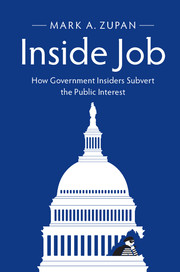Book contents
- Inside Job
- Inside Job
- Copyright page
- Contents
- Preface
- Acknowledgments
- 1 Government for the People?
- 2 Why Worry about Government Insiders and Their Profits?
- 3 How Do Government Insiders Profit at the Public’s Expense?
- 4 What Do Government Insiders Stand to Gain?
- 5 What Factors Curb Hijacking by Government Insiders?
- 6 Why Are Government Insiders So Hard to Control?
- 7 Where and When Has the State Been Co-Opted from Within?
- 8 Government Insiders: A Day of Reckoning for China?
- 9 Government Insiders: A Day of Reckoning for the United States?
- 10 How Can We Form a More Perfect Union?
- Bibliography
- Index
- References
Bibliography
Published online by Cambridge University Press: 06 April 2017
- Inside Job
- Inside Job
- Copyright page
- Contents
- Preface
- Acknowledgments
- 1 Government for the People?
- 2 Why Worry about Government Insiders and Their Profits?
- 3 How Do Government Insiders Profit at the Public’s Expense?
- 4 What Do Government Insiders Stand to Gain?
- 5 What Factors Curb Hijacking by Government Insiders?
- 6 Why Are Government Insiders So Hard to Control?
- 7 Where and When Has the State Been Co-Opted from Within?
- 8 Government Insiders: A Day of Reckoning for China?
- 9 Government Insiders: A Day of Reckoning for the United States?
- 10 How Can We Form a More Perfect Union?
- Bibliography
- Index
- References
- Type
- Chapter
- Information
- Inside JobHow Government Insiders Subvert the Public Interest, pp. 208 - 223Publisher: Cambridge University PressPrint publication year: 2017



